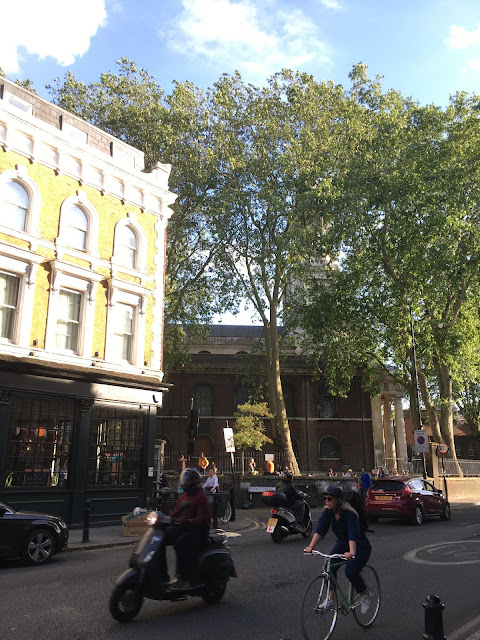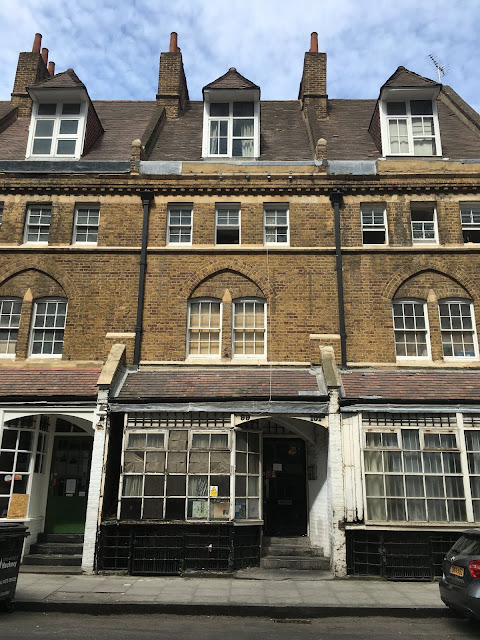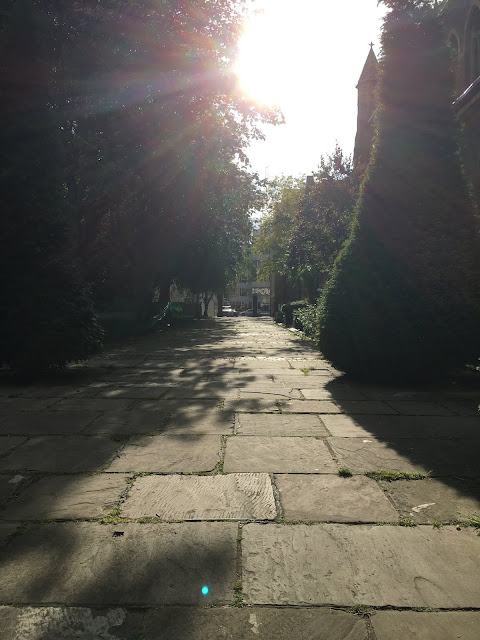Out And About In Shoreditch
Many are already familiar with Shoreditch as sort of breeding ground for hipsters and artists, as well as a night out destination for more mainstream city types and Essex crowds. Research for this article was carried out during nationwide “lockdown”, which has provided a great opportunity to observe historic sites and buildings, and has helped me to imagine an older version of Shoreditch. A Shoreditch devoid of motor vehicles, mobile phones, ugly new builds, and all of the trappings of modern life. A time when public buildings were built well and in a way that would stand the test of time. Many gems are hidden in the side streets and back allies away from the main thoroughfares. Here one will find awesome and haunting edifices in the form of old churches, consistently good examples of workshops and warehouses from the Victorian and Edwardian eras, some nice Georgian houses and one or two decent recent developments. These along with myriad boutiques, some great fooderies (still powering through lockdown) and some charming green spaces. After many years of passing through I can now clearly see why it has become a very desirable and fashionable place to live.
All Fixed Up
One thing which is essential if you are exploring Shoreditch is a hipster fixie bike, like this…
Its flat terrain makes it a very enjoyable area to explore by bike. Indeed it suits my latest bike the Foffa single speed premium. Being a Dutch brand the Foffa is designed with the flat landscape of Holland in mind. Cycling uphill is a struggle. I had the hub size taken down a couple of cogs after purchase to facilitate this which helped a bit, but it’s much happier on flat ground. Indeed I can see why these kind of bikes are popular in this area and all over Hackney. I have the flip flip hub set to fixed.
A favourite with cycle couriers, the fixed wheel makes sense. As a cyclist one feels more connected with the bike and short journeys can become easier. With roads in London being usually short and busy (even during lockdown), changing gears is hardly worth while. Hence the fashionable fixie. I have extra breaking power and more control of the bike generally, so the breaks don’t need changing that often. Cycling downhill isn’t as fun but probably a bit less dangerous. I just miss in lazy weather like this being able to cruise around without my legs going. But now that I’m used to riding fixed, riding freewheel feels weirdly out of control and scary, and I’d have to be breaking all the time.
The Brooks bag is super appropriate except for one thing; it doesn't work very well as a bag. I'm scared to put too much in it after I noticed one of the straps had started to come away. Maybe that's my own fault for taking abroad as hand luggage instead of use it for its intended purpose. Ok, its lots of different sections and pockets which I like, but for £170 I just expect a bit more. Nor is it waterproof, like I thought it would be. I usually use a yellow Ortleib; a much better investment. Its strong enough to carry anything you can stuff into it and is totally waterproof. £80. Foam pads keep the bag off the back which improves ventilation. The interior is cavernous though, so for carrying a Pevsner book and some light refreshments around Shoreditch, the Brooks is fine.
The unusually warm weather of late has given me the feeling that I could be on holiday somewhere, exploring a strange city by bike. In fact I’m just staying here for a few weeks whilst off work and so have decided to make the most of it. When staying anywhere it is always absolutely imperative that one takes the time to check one’s surroundings and to learn a bit about the history of that place, otherwise we risk missing out big time, like I do, continuously. I owe many of the discoveries and observations here to the Pevsner buildings of England guidebook volume “London 4: North”.
Shakespeare's Shoreditch

In the middle ages was an Augustinian priory west of the high street, known as Holywell. Near this site by Curtain road was built London’s first theatre 1576, where Shakespeare would have performed his plays. Around this time, Hoxton was just one large street and Haggerston was a separate little village. If we walk around these streets today we see no tangible reminder of medieval or Elizabethan times apart from some street names: Holywell Row, Worship street and Curtain Road (Curtain referring to the old curtain wall of the priory).
Streets and Workshops South of Great Eastern Street
There are however one or two places worth a look as they could be easily overlooked (as they were by me on numerous occasions).
Scruton street has a small Italian deli called LA SPIGA worth visiting if hungry. They sell homemade pasta, which is something not to be snuffed at. Next door is a sushi restaurant (currently closed) which looks the business.
At the east end of Worship street: No.s 91-101; a terrace with built in shopfronts with industrial basements designed by Phillip Webb, 1863. Built by a philanthropist to house his workers, and to improve the squalid living conditions in the area. An earlier and more successful social housing project than many to come later. Some nice angles coming of the shop windows, gothic drinking fountain, and eclectic use of Queen Anne windows under gothic arches on 1st floor windows. Without cars its possible to walk around get the feel of a Victorian street, and a pretty stylish one at that. A sandwich shop is still open and construction workers are going there for lunch.
Some good examples of Victorian workshops can be seen on Phipp Street, Leonard street and around the area. Many were dedicated to the furniture and timber trades. They usually have pilasters or piers unifying 3/4 stories, with large windows between. Many of them still have wall cranes attached to the outside of the buildings. Designed to allow maximum natural light into the rooms, these buildings became occupied by artists and designers and most have now been converted into expensive flats.
Quiet Time
Between Leonard street and Luke street is the former ST MICHAEL’S church and grounds. These small green spaces, often former church yards, are invaluable to a big city like London, especially for people without gardens who are not allowed to smoke at home. Not for me the big exposed parks where joggers congregate, children run around unchecked and the wind carries the titinitous sound of music played on mobile phones.
This is probably the best churchyard in Shoreditch for peace and tranquility and in a picturesque setting. The garden is well kept and is under the shadow of the huge Victorian church, built 1863-5. Designed by James Brooks, his first in the area. The church has a tiny steeple with an octagonal turret. Gables have patterned brickwork not seen on his other churches in the area. Adjacent were a group of buildings by the same architect; school, clergy house and hospital, some of which survive. Also seen here everyday is the pied wagtail of Saint Michaels. If you sit still he may come close. There is one bench marked “courier bench” although I haven’t seen the couriers yet.
James Brooks : Church builder
Brooks was commissioned by Haggerston church committee to design 5 churches in the area. 3 of which survive, all easily reachable by bike, and easily recognisable as they are huge and have distinct appearance. His buildings are impressive especially when considering their context and purpose as fairly low budget grand scale projects meant to impress inhabitants of the poor areas. All made from red brick and done in an early gothic style, they stand out from most other churches of the period. Little details repay closer inspections like interesting brickwork, turrets and doorways.
He was particularly good at composing groups of ancillary buildings around the churches. ST CHAD, 1867-69 has a good vicarage. ST COLUMBA still shows school, clergy house and mission house. This kind of thing was a manifestation of the Victorian vision of the ideal community in which the people are fostered by the church on various levels, and these institutions were attempting to reach out into poor communities.
As an atheist I always managed ok without Sunday school, yet there is something nice I think about this kind of community spirit. Also as far as churches go, I enjoy them not for what they represent, but for the effect that their forms have on me as a casual observer. I also enjoy noticing little details that might be missed at first glance and for that I usually need some help, usually in the form of a Pevsner book. Architects and craftsman were hired to create works that aimed to transport people above and beyond the ordinary, at a time without cinema or television and mass illiteracy. Sometimes they succeeded.
Saint Leonard & Saint John
Other churches with grounds worth visiting in the area by bike: ST LEONARD’S, by Charles Dance Sen. in 1736-40. On a grand scale comparable with Hawksmoor’s East end churches. Cupola on a tall steeple which rises high (192ft) above the busy cross roads at the junction of Old st, Shoreditch high st, Hackney Rd and Kingsland Rd. Its grounds are impressive but usually busy. Sometimes I will go to one of the hidden seating area behind the rose bushes. Up the road is an expensive French food shop called THE GROCERY where I found this CBD infused beer. It has to said that the shop does sell some outstanding products, especially the baguettes. Since that day though I have only found the non-alcoholic version which was actually going down fine until I noticed.
ST JOHN THE BAPTIST has a good garden also. Another monumental church in the classical style with giant ionic columns on the west front. Again a few too many people for my liking. While I am out and about I am also being careful, keeping my distance and generally trying to avoid others as much as possible. For me this is standard behaviour but now the government has made it easier. South of here on Pitfield Street, some proper fish and chips are being dished out which do not disappoint and are not over priced.
Old Pubs of Shoreditch
On this street are also two good examples of old East end pubs: THE HOP POLE, 1900 with its green glazed-tiled ground floor and baroque detail up above, and THE GEORGE AND VULTURE, rebuilt around the same time. Both feature their name in bold lettering high on the facade as if to attract the weary traveller from afar. My vision of these establishments is probably romanticised. I imagine a cosy fire in winter and lively banter round the bar and round all tables, no music unless people playing, no people sat by themselves on mobile phones, no Sky sports, no gambling machines, no Fosters, just a great atmosphere. Though I love their outward appearance, I’ve been disappointed by going inside traditional looking pubs too many times and so now I always tread with caution and have a good look through the window first.
In the good old days pubs used to be public houses, or inns, where people stayed for a number of days and made themselves at home. Staff would live there, perhaps having their own floor. Locally sourced homemade food would be served as a matter of course without costing an arm and a leg. Imports would be specialities. There probably wouldn’t have been many children in there either. And people would have smoked, a lot. The buildings were designed as pubs and to be clearly recognisable as pubs from the outside, like the red brick Victorian primary schools. Other good examples are THE OLD BLUE LAST, 1876, which curves round the corner of Curtain Road and Great Eastern Street, and is usually a great place to see live music for free, THE CROWN AND SHUTTLE on Shoreditch High Street with ornate facade and stepped gable. THE UNICORN on Hoxton street for its relief of a unicorn, actually just a white horse dressed as unicorn.
Perhaps the best old pub building is YE OLDE AXE on Hackney Road. It has many interesting features such as an octagonal corner turret with clock, tiled first floor and sculpted gable showing the pub name and symbol under a scallop shell. This venue was one of the many now closed East end strip bars.
Hoxton Street
The only pub open at this time during this time is one called HOWL AT THE MOON on Hoxton street. People are queuing 2m apart to buy beer in take away jars which they are then drinking on the street in tightly huddled groups. Many ordinary folk are already starting to completely do away with socially distancing since the Prime minister’s vague statement last week. The other half of the population are locked away indoors scared to venture out for various legitimate reasons.
But its not the pull of draught beer that compels me to put myself and others at risk, its the homemade burgers which they are serving. With only a trangia stove at home to cook wth, the temptation to buy take away is sometimes too great. The burgers are outstanding. Next door is a charming garden open to the public (though not right now). The clock that stands in the grounds was brought from the old Homerton hospital that was replaced. Further down is the former Hoxton music hall, adding yet more to the area's rich theatrical heritage.
The Expanding Population: Its Effect On Building Types
For Georgian terraces see Hackney Road No.s 237-41 and Christopher Street No.s 15-23. In Hoxton square there is a quirky gothic house at NO. 10. Opposite, across the square, a recreation of a 17th century house, giving an idea of how the square was when originally laid out. Before the furniture trades began to dominate the area in the mid 19th century, Shoreditch was a home of wealthy merchant types. By 1750 there were 2,500 houses here and 10,000 citizens. The population had grown to over 100,000 by 1850.
In Hoxton square a lyrical sculpture of a juggler celebrating the circus training centre north of the square, in a former electricity station. At Charles Square, a good house of 1727, made of red brick and with a carved doorway. Around it are typical post war flats. Victorian Shoreditch had many slum areas, all eventually cleared away and replaced by public housing. One of the best intentioned examples of early housing schemes are On the east side of the street and in Goldsmiths square, built 1894 with red and yellow brick bands on the gables. They're nothing to blow anyone away but compare them, if you will, with the surrounding post-war flats built by the same council. Perhaps the most oppressive mass housing solutions are the two towers north and south of St Chads in Haggerston called FELLOWS COURT. The north one towers over a bleak shopping area with a cheerful little community centre which runs music classes.
Goldfinger
Nearby is a more successful venture in modernism; HAGGERSTON SCHOOL by Erno Goldfinger, 1962-7. This architect was the inspiration for the bond villain and was a neighbour of Bond author Ian Flemming on Willow Road, Hampstead. Here he is said to have raised the bar for most secondary schools of the date. Subtle details reward closer inspection; windows which either wrap around the side of the building, monumental gutters, elegant spiral staircases, decentralised plan. Even smaller buildings are well proportioned with some nice features.
Street Art Shrine
Not far from here is a good place place to see a particular sub-genre of street art, transient in its nature, and an important part of the urban fabric. On a little lane called Diss street just off Hackney road. A little urban space has become a sort of shrine to street art. What its about I cannot say, only that I like it.
These observations have been compiled over numerous mini visits and explorations over a few weeks. Its far from an exhaustive account. With one more week to go here I feel I’m hardly even scratching the surface. I hope that all of the historic buildings remain here a while longer. As they all have protected status I expect that they will be. But the nature of Shoreditch is ever changing. The arty types who made Shoreditch super hip not that long ago have now largely been priced out. I have come to the conclusion that people who live in Shoreditch must fall into one or more of these categories:1. Live in social housing, have lived here all of life and have family in area, 2. Are very good at what they do and can afford the high rent or house prices, 3. Have gift of the gab and/or are very well connected or 4. Have too much money and just want to spend it in a fun way. I am very grateful that I have been allowed even a short time here to absorb the ambience of the place and to learn a bit about its history. Here’s hoping that you will find the time also one day to discover or to rediscover this quieter, older, less well known version Shoreditch that exists now only in the imagination.
























